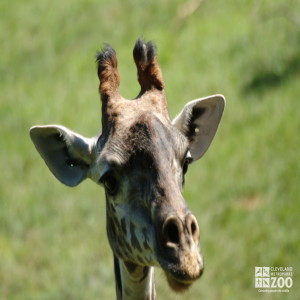Masai Giraffe
[Giraffa camelopardalis tippelskirchi]

The Masai Giraffe is the tallest living mammal, standing an average of 16 to 18 feet for a male and 1 or 2 feet less for a female. Weight can range to a maximum of 1,760 pounds. The long neck has the usual 7 vertebrae, but each is quite long. In fact, all the bones in a giraffe are long. The coat consists of brown or reddish blotches on a lighter background. The pattern of the coat varies and is an aid for camouflage with the different habitats. The skin pattern for an individual giraffe is constant throughout the giraffe’s life. With the changing of season and health, the coat color may be altered. Giraffes have a steeply sloping back from the shoulders to the rump. Their tails are thin and long. A black tuft at the end of the tail whisks away flies and other flying insects. Giraffe horns are unlike those of other mammals. They are present at birth as cartilaginous knobs and become bony later as the animal matures. Eventually the horns fuse with the skull. They are like deer antlers that are in permanent velvet.
Location: African Savanna
Future For Wildlife
Share:
Range
The range of the Masai Giraffe is Africa south of the Sahara.
Habitat
The Masai Giraffe inhabits savannas.
Conservation Status
EndangeredPrimary Threats
Human Wildlife CoexistenceGestation
15 to 20 months depending on nutrition of mother
Litter
1
Behavior
Giraffes are social animals, living in loose, open, unstable herds varying from 10 to 20 individuals, although herds of up to 70 have been observed. Individual giraffes join and leave the herd at will. Herds can include all female, all male, female with young calves, or mixed genders and ages. Female giraffes are more social than male giraffes. Isolated individuals can also be encountered in the wild. They spend the day browsing but at night retire to an open area where their great height and excellent eyesight make it difficult for a predator to approach unobserved. They take turns sleeping, with one or two always on guard. They pull leaves off twigs with their long prehensile tongues ( 18 inches long) which are blue-purple in color to prevent sunburn.
Reproduction
Giraffes are polgynous. Bulls carefully guard an estrous female from other male giraffes. Conception occurs in the rainy season, with birth occurring in the dry months. Most giraffe births take place from May to August. Female giraffes breed every 20 to 30 months. The gestation period is about 457 days. The calf is born with the mother standing and undergoes a 6 foot drop as its introduction to the world. A calf weighs 100 to 150 pounds at birth, and stands 6 feet tall.
Wild Diet
Leaves of acacia, mimosa, and other trees
